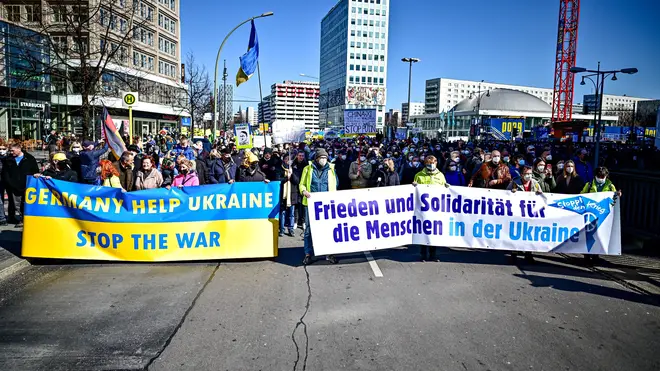
James O'Brien 10am - 1pm
13 March 2022, 18:14

Demonstrations were staged in cities including Berlin, Warsaw and London.
Tens of thousands of people held rallies in cities across Europe on Sunday to protest against Russia’s ongoing war in Ukraine, with small vigils taking place in Russia as well despite a crackdown by authorities against such demonstrations.
German trade unions called a protest in Berlin, where sunny weather boosted the turnout. The march led from the city’s Alexanderplatz — a large square named after Russian tsar Alexander I — to a site near the Brandenburg Gate.
Many participants carried flags in the blue and yellow colours of Ukraine, while others held banners which read “stop the war” and “peace and solidarity for the people in Ukraine”.

Norbert Herring, who held up a sign that read “what are you doing to your neighbour?” as the crowds filed past the Russian embassy, said the images from Ukraine reminded him of the bombing of cities during the Second World War.
Several participants at the Berlin protest said they were Russians ashamed about what their country was doing.
“We’re against this war so we wanted to show our solidarity,” Aleksandra Belozerova, a Russian studying in Germany, said.
“It’s the least we can do in this situation.”

Her friend, Aliia Biktagirova, held a sign with letters for the Russian phrase for “no war” represented as asterisks to reflect the censorship she said was taking place in Russia concerning the conflict.
In Russia, where demonstrations against the war in Ukraine have been typically met with a heavy police response, human rights group OVD-Info said more than 668 people had been detained in 36 cities as of late-afternoon Moscow time.
There was a heavy police presence at central locations including Manezhnaya Square near the Kremlin, with officers carrying demonstrators away to waiting police vans, in footage posted by Russian media.
The number of people protesting nationwide appeared to be far fewer than the last major protests a week ago, when OVD-Info listed more than 5,000 people who were detained.

Anti-war protests were also staged in Warsaw, London and the German cities of Frankfurt, Hamburg and Stuttgart.
A small far-right party organised a protest in Serbia’s capital, Belgrade, in support of Russia’s invasion of Ukraine.
The occupants of dozens of cars waved Russian and Serbian flags, honked horns and chanted slogans in favour of Russian president Vladimir Putin. Some cars had “Z” painted on them — the letter is used on Russian armoured vehicles in Ukraine and is now a symbol of support for Russian troops.
Despite formally seeking European Union membership, Serbia has refused to join international sanctions against its ally Russia despite voting in favour of the UN resolution condemning Moscow’s aggression. The country’s dominant state-controlled media carries frequent pro-Russia reports about the war.

One day after rallies in Florence and Naples, Italians and Ukrainians who live in Italy turned out for protests in Milan and Rome on Sunday against the war in Ukraine.
In the first row of a march in Milan, Italy’s financial capital, protesters held bloodied cloth bundles to represent children killed in Russian attacks on Ukrainians. Some children held drawings, and many marchers painted their cheeks in the colours of the Ukrainian flag.
In Rome, Pope Francis decried the “barbarianism” of the killing of children and other defenceless civilians in Ukraine. He told a crowd, estimated by the Vatican to number 25,000, gathered in St Peter’s Square for his customary Sunday noon appearance, that the attacks must stop “before cities are reduced to cemeteries”.
In Cyprus, dozens of Russian nationals joined Ukrainians in the coastal resort town of Limassol on Sunday to protest against the war in Ukraine.
About 50 Russians converged on the town’s promenade prior to joining with other protesters to chant slogans such as “stop the war, stop Putin” and waving blue-and-white flags they said where the Russian national flag without the red stripe that represented “blood and violence”.